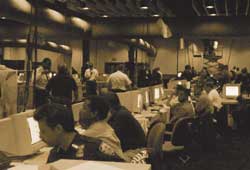ArcUser Online
 |
After initial training, most EOC staff, who were familiar with New York City operations, were quickly able to apply those operations within the E Team system framework. After training podium staff, we turned our attention to the emergency support functions (ESF) including the remote staging areas and mobile command posts. Troy and John handled most of the support functions while I started working on the mobile E Team setup. Pioneering a Wireless Solution E Team supplied real-time data from multiple locations in New York City that improved rescue and recovery operations. The system functioned so well that the next step was to deploy it to forward command posts and forward staging areas. To accomplish this proactive step, a wireless solution was needed, as the communications infrastructure had been damaged in the collapse of the towers. Although E Team had done some testing using the system with wireless communication, we were really pioneering the wireless E Team solution. We decided the best configuration would be to run the Lotus Domino server on each client (i.e., mobile unit) along with ArcIMS. In the background every few minutes, the server would replicate data with the central OEM computers using a wireless connection. The client would experience no noticeable performance loss when utilizing this system, and it would allow efficient exchange of data. Panasonic TOUGHBooks with built-in Serria wireless modems were chosen because these notebook computers ship with the Integrated Wireless solution that supports Cellular Digital Packet Data (CDPD), a specification for supporting wireless access to the Internet and other public packet-switched networks. These rugged computers were also chosen for their shock-, moisture-, and dust-resistant design. Preliminary Field Testing Late Sunday night, September 16, we had the first unit up and were ready to perform preliminary field tests. I have learned from many years of experience in deploying technology to field operations in fire rescue, emergency medical services, and emergency management situations that rapid testing in the field was necessary. Technology is like any other tool. Providing a carpenter with a hammer that does not work properly just makes the carpenter's job much more difficult, perhaps impossible. Field personnel at the WTC were already doing one of the hardest jobs in the world. If our wireless solution was going to work, it would have to perform as expected without any complications. Technology that works is phenomenal; technology that doesn't work hurts people. In the early morning hours of Monday, September
17, Troy and I went to the 1010 Duane Street command post with the
mobile units. For most of the trip, the wireless connection was
good, and the databases were replicating properly as confirmed by
the E Team systems administrator. As we neared the command post,
wireless communication became intermittent-it would spike for a
few seconds then go back to a search mode. These connection problems were due mostly to the loss of cellular towers in the area. When we finally arrived at the command post, the connection was not working. Although the system would perform fine locally because the server was installed on the computer, the database could not update and the user would have only static information. We were unable to close the loop from the field to the EOC and staging areas. John put me in touch with a representative from Motorola who helped me locate wireless connectivity specialists at Verizon. I learned that most of Verizon's infrastructure was still operational and that Verizon had set up mobile transmission sites called Cows (communications on wheels) to support the area. CDPD wireless connectivity could be utilized with a few minor adjustments. If we provided specific maps of the area needing coverage, Verizon would ensure reliable connectivity. Verizon provided me with a new IP address for the mobile units and assured me that, by the morning, the area would be saturated with coverage. Continued on page 3 |
